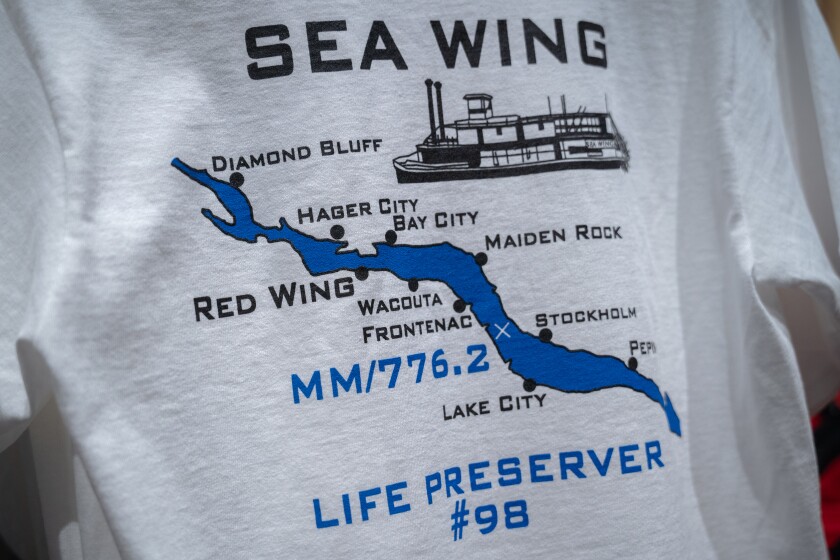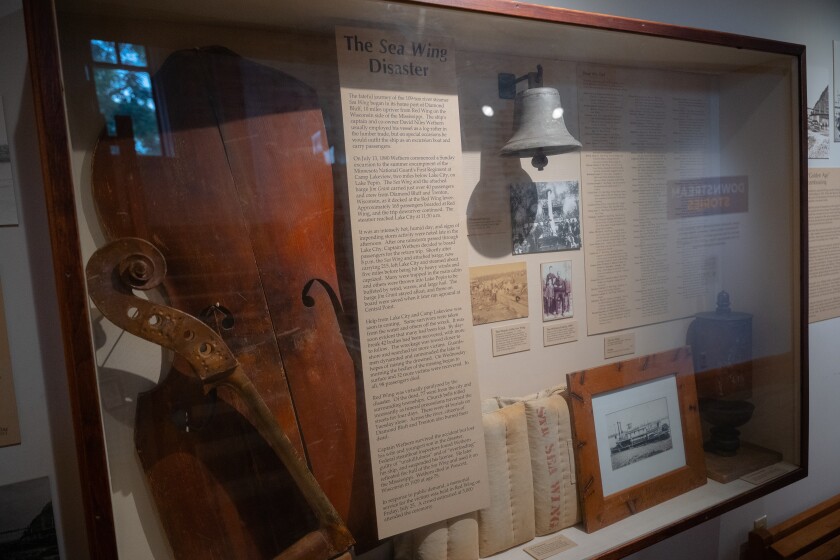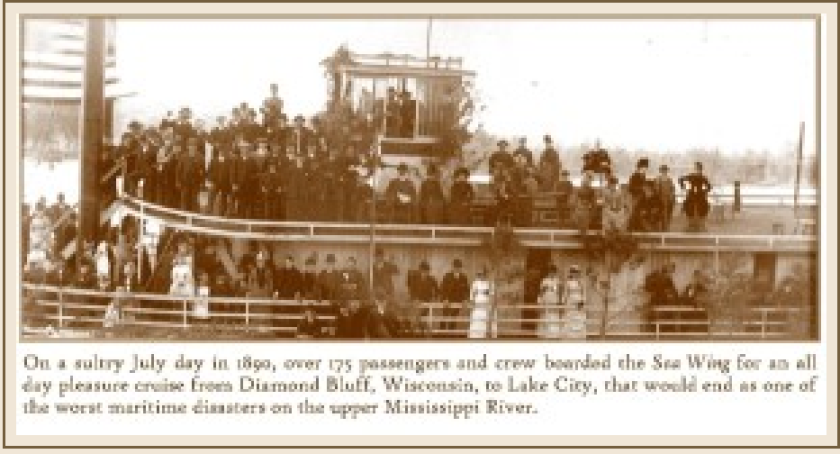Editor's note: This archival Vault article was first published Aug. 23, 2022.
RED WING, Minn. — When Frederick Johnson told his aunt that he was planning to write a history about Minnesota’s worst maritime calamity, her reaction was one of disbelief.
ADVERTISEMENT
Well, everybody knows that story. Why would you want to write about that, the Red Wing woman said.
Her attitude speaks volumes about why the historical memory of the Sea Wing disaster on Lake Pepin extends so little beyond Red Wing, Minn., the small river town that suffered the greatest loss of human life from the accident.
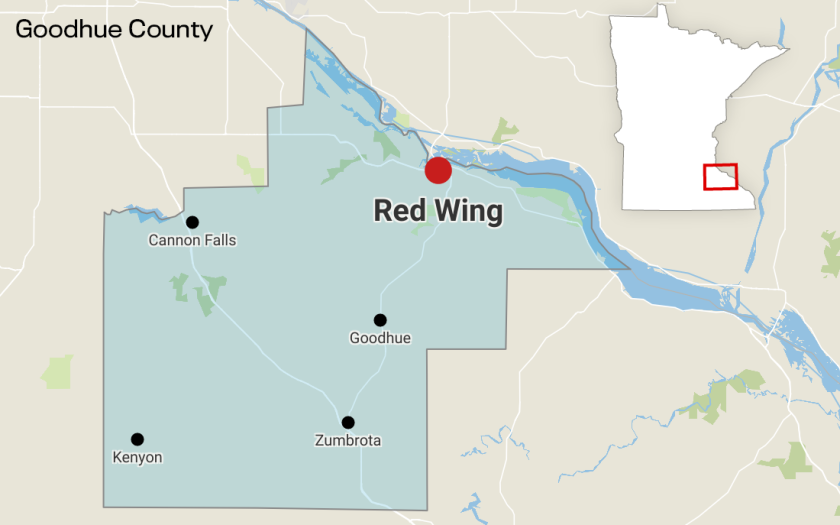
On July 13, 1890, the steamer Sea Wing was returning from a carnival-like day at a military encampment when it capsized from a sudden and violent storm.
Many of the excursionists made the understandable but fateful decision to retreat to the ship’s passenger cabin for protection. When the ship flipped over, they were trapped inside the upside-down boat and drowned.
Ninety eight passengers – nearly half of the people on board – died as they were tossed into or submerged in the churning waters.
The sense of tragedy was accentuated by the fact that the day had begun so promisingly: a pleasure cruise down the Mississippi River from Diamond Bluff to a National Guard encampment at Camp Lakeview near Lake City.
Popcorn, lemonade and ice cream stands had been set up around the encampment. Passengers danced to a four-string band on a barge attached to the steamer’s port side as they coasted down the river.
ADVERTISEMENT
The day was cast as the “social event of the season,” the only discordant note being the warm and humid weather that portended the possibility of foul weather.
Of the 57 women on board, 50 of them drowned. Many young women had boarded the ship wearing their Sunday best. Their heavy fabrics and long dresses made swimming nearly impossible, even if they knew how to swim.
Whole families died in Lake Pepin’s waters. Many were in their teens or early 20s. Some were couples, newlyweds or days away from marriage. It claimed children and toddlers. Red Wing bore the brunt of the loss — 77 out of the 98 who died came from that city.
After the bodies were recovered and the victims identified, Red Wing became a city of mass mourning and grief, holding round after round of funerals and wakes.

Survivors bore a lifelong sorrow. Annie Staiger, 20, and her sister, Frances, 18, of Florence Township, Minn., both perished in the storm. They had been accompanied by two young men, Frank Lampman and Ed Stevens, who had tried to save them.
Their father, John Staiger, was lacerated by heartache for the rest of his life.
He would sit and cry each day after work as “he gazed sorrowfully at his daughters’ pictures in the family's best room,” recalled Mathilda, who was 7 at the time and the youngest of the daughters, according to Johnson’s book, “The Sea Wing Disaster: Tragedy on Lake Pepin.”
ADVERTISEMENT
It forever altered the trajectory of families’ lives, stricken with grief as they were. William Blaker lost his wife and two children, and within days of burying them, put up his house in the west end of Red Wing for sale. Sara Adams of Trenton lost three children, two nieces and a nephew, turning her coal-black hair to gray around her face.
During the recovery of the bodies, relatives held out hope that their loved ones had survived.
Eliza Crawford, a Ohio native who had moved to Goodhue County to teach, was one of the missing in the days after the incident. She had told family members how much she enjoyed teaching “these Norwegian boys and girls,” and had just completed her first month of teaching.
Her uncle, H.W. Keller, refrained from informing the family about her possible death, then wrote a letter while she was still missing.
“There were whole families lost,” Keller wrote. “As far as I know there were only five females saved. There were life preservers on the boat, but few availed themselves of them. There is mourning in Red Wing as nearly all were from there.”
She was later discovered among the drowning victims.
It has been referred to as Minnesota’s Titanic story. Yet for such a shattering life-searing event that reverberated across the nation, it is easy to wonder why the history isn’t better known beyond Red Wing. Many beyond the city's immediate vicinity are often surprised when they first hear about it.
By the time Johnson began his research into the Sea Wing mishap in the early 1980s, it was perhaps a generation removed from being forgotten.
ADVERTISEMENT
When he began combing the Minnesota Historical Society’s archives, the only document he could find was a commemorative booklet, “In Memory of Those Who Perished.” It was prepared for a July 13, 1890, memorial ceremony in Red Wing.

“Just fix in your mind that it was so localized,” said Johnson in explaining why one of the country’s worst maritime tragedies is not better known.
“(Seventy-seven) of the dead were from Red Wing,” he said. “And then the rest were from Wisconsin. There was nobody from out of town.”
Johnson’s aunt’s disbelief that he wanted to write a book about the Sea Wing also held implications for that history.
The older generations were all familiar with the accident, the worst accident in terms of lives lost in Minnesota history. But as that generation died off, it became less well-known although never completely erased.
“They just didn’t talk about the Sea Wing,” Johnson said. “As far as I can tell, the farther one got from Red Wing, Lake City and Lake Pepin, the less known the accident was.”
It was no small feat assembling a narrative from the conflicting stories as reported by the media at the time. The Twin Cities media often sensationalized the incident, often reporting whispered rumors as fact.
ADVERTISEMENT
The horror-filled event needed no exaggeration, yet their headlines were often over the top and tabloid-like: “A Voyage of Pleasure That Ended on the Shores of Another World,” screamed one. “The Sea Wing Becomes a Floating Sepulcher for Pleasure Seekers in Its Cabin,” said another. “The Tornado on Pepin’s Bosom the crowning calamity of all Minnesota Annals,” crowed another.

Local media, closer to the event, tended to report more responsibly.
Many of the conflicting narratives centered on the ship’s pilot and co-owner, David Wethern. He had steered the ship into the straight-line winds as he was supposed to, but in the event’s aftermath, he was dogged by questions about his judgment and conduct.
One of the biggest questions was why Wethern chose to hazard a return along the Mississippi with the weather looking so threatening.
Still, “most people got on the boat,” Johnson said. “You know the mindset. ‘I want to get home tonight.’”
Inspectors eventually charged Wethern with “unskillfulness,” particularly his decision to start out in the face of an approaching storm and failing to hug Minnesota’s shoreline where there were many harbors for protection.
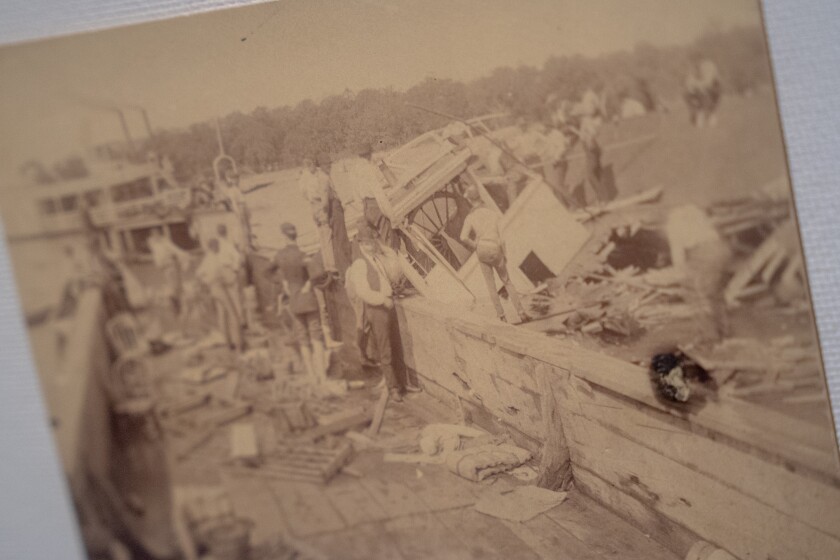
Still, Wethern was not without allies, and he was an object of sympathy. He had lost his wife and a child in the accident.
ADVERTISEMENT
This charitable view was reflected in the fact that in the aftermath, Wethern remained a figure of social standing. He wasn’t treated as a pariah. He stayed active in fraternal organizations in Red Wing and Prescott. In Diamond Bluff, where he lived and where the ill-fated excursion of the Sea Wing began, he served as town board chairman and treasurer. He remarried.
Life moved on.
“The Twin Cities papers were very critical of him,” Johnson said. “But when it was found out that he had lost his wife and a son, people were, ‘It was an accident after all.'”
